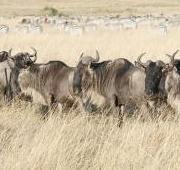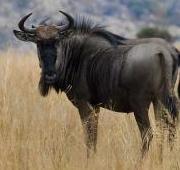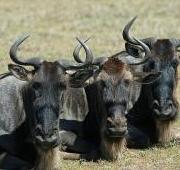 The wildebeest is actually a subspecies of the antelope, despite it's bull-like appearance. There are two known species of wildebeest, both of which are native to Africa.
The wildebeest is actually a subspecies of the antelope, despite it's bull-like appearance. There are two known species of wildebeest, both of which are native to Africa. The changing African seasons mean the wildebeest must migrate south in the winter, so the wildebeest can continue to graze on grass. Thousands of wildebeest all tend to migrate at once creating a wildebeest stampede.
The changing African seasons mean the wildebeest must migrate south in the winter, so the wildebeest can continue to graze on grass. Thousands of wildebeest all tend to migrate at once creating a wildebeest stampede.


When the baby wildebeest are born, they are often able to stand within a matter of minutes and these young wildebeest are soon able to run around and soon learn about the importance of protection in numbers. When the wildebeest are migrating around the African continent, the young wildebeest always stay very close to the mother wildebeest as it is easy for the young wildebeest to get lost when there are so many wildebeest traveling together or be preyed upon by watching predators.
Wildebeest inhabit large plains on the African savanna where there is plenty of food for the wildebeest to eat. Wildebeest are herbivorous animals and graze on grasses, leaves and shoots.
Wildebeest live together in large herds in order to protect each other as on their own, wildebeest are defenceless and therefore vulnerable in the African wilderness. When danger is spotted, the wildebeest warn each using groaning calls and then run together creating a stampede, both to escape approaching predators and also to intimidate them.

